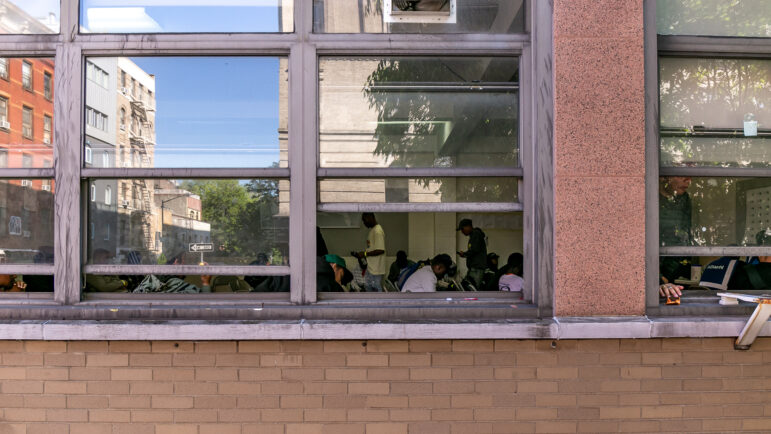“The Adams administration, simply put, must do more to address the historic crisis of youth homelessness our city faces. Instead, the administration has made policies that will create a worse situation for some of the most vulnerable young people.”

Adi Talwar
A window outside the St. Brigid’s School in the East Village, which is now serving as a “reticketing center” for migrants seeking more time in the shelter system.In March, city officials announced a settlement that limited the right to shelter. Many of those who will be most impacted by this agreement are Black and Latinx. Some are LGBTQIA+ young people we see daily at the Free to be Youth Project, including youth who are fleeing discrimination or torture due to their sexual orientation or gender identity.
Like all homeless youth, those who have recently come to the United States face a gauntlet of limited or non-existent youth-oriented services, bureaucratic barriers, and high-risk encounters with police. But they also face barriers to services in the language they speak, and must navigate a complex immigration system, typically with almost no support and no legal representation.
LGBTQIA+ homeless youth are disproportionately likely to suffer serious violence and experience suicidality, while migrant and refugee homeless youth are at high-risk for exploitation and violence. Now, they will be systematically pushed onto the street by cruel municipal policy, putting them at further risk for life-threatening harm.
The Adams administration, simply put, must do more to address the historic crisis of youth homelessness our city faces. Instead, the administration has made policies that will create a worse situation for some of the most vulnerable young people.
Historically, homeless young adults had access to the Department of Homeless Services (DHS) shelter system, which administers beds under various legal settlements that had amounted to a “right to shelter.” DHS is often not the preference of many young people because it can be very dangerous for them, but it is an option many have accepted, which has heavily-regulated minimum standards the city must attend to.
Typically homeless young people have preferred youth-specific shelters run through the Department of Youth and Community Development (DYCD). However, eligibility for the vast majority of those beds ends on an individual’s 21st birthday. These beds are scarce and often invisible to young people—there are only 813 of them for thousands of youth across the five boroughs, and no centralized way to access them.
In 2022, the mayor created a separate and unequal municipal shelter system specifically for migrants, run by the Health and Hospitals Corporation, and then steadily pushed countless asylum-seekers—including young adults—into it, while simultaneously closing the door into the DHS system. These shelters, called Humanitarian Emergency Response and Relief Centers (HERRCs), include the cots and massive tents on Randall’s Island that have made headlines and appalled so many of us.
What became ensconced in the settlement announced last month, which is official municipal policy, was in large part the framework the mayor had created over the preceding two years.
Many homeless youth and young adults who meet the mayor’s arbitrary definition of “new arrival” are now systematically blocked from accessing DHS shelter, often unable to find or get into DYCD beds, and facing extremely tight time-limits in HERRC shelters.
Youth and young adults in the HERRCs under age 23 will now have 60 days before the city can deny them a bed, while everyone else has 30 days. According to recent reports, New York City has already issued 1,300 eviction notices to these vulnerable young people.
Decisions about whether young people will get any extension will largely be left to the discretionary decision of city bureaucrats, likely without any advocate involved to provide support. Just last week, city bureaucrats denied nearly half of the first 29 migrants who had applied for extensions and been interviewed.
If a young person does not meet a particular standard for additional time they will likely end up on the street, where they will face an array of life-threatening risks. Hundreds of migrants ran out of time and faced eviction as of last week.
This is unacceptable, and it is a major reason why the mayor’s cruel push to limit shelter stays for anyone, particularly young people, is so dangerous and appalling. For LGBTQIA+ young people, the risks are particularly acute.
For homeless youth new to New York City, including LGBTQIA+ youth, sleeping on the street can lead to catastrophe. Young people are at increased risk for individualized violence, targeting by police for crimes of poverty, sweeps by municipal agencies, and sex trafficking.
The Adams administration must expand the number of shelter beds within the homeless youth system, run by DYCD. Youth shelters tailor age-appropriate services specifically to the needs of the homeless young people they help. The city has not added any new youth beds since the mayor took office.
The Adams administration can help decrease the risks faced by LGBTQIA+ youth by also ensuring that any new beds, in any of the shelter systems, include specific programming and training for serving these young people, as well as adding specific LGBTQIA+ beds within all the homeless shelter systems.
New York City officials must ensure protections for all homeless youth who have recently migrated, and they need to pay particular attention to the risks faced by LGBTQIA+ young people, who are now some of those who will be pushed onto the streets by cruel municipal policies.
Amy Leipziger is the project director of the Free to Be Youth Project of the Urban Justice Center.








